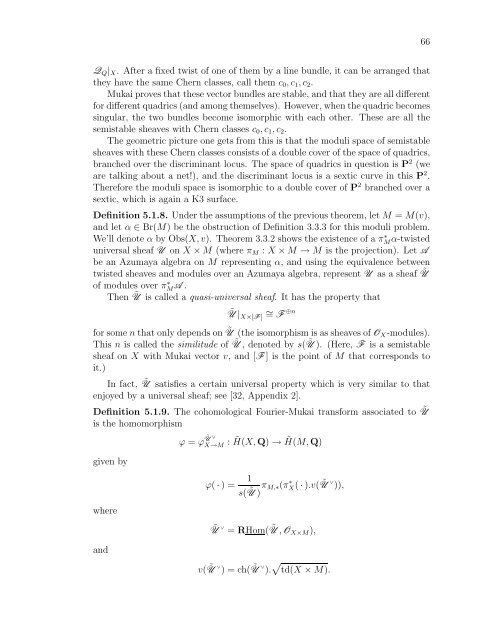derived categories of twisted sheaves on calabi-yau manifolds
derived categories of twisted sheaves on calabi-yau manifolds
derived categories of twisted sheaves on calabi-yau manifolds
Create successful ePaper yourself
Turn your PDF publications into a flip-book with our unique Google optimized e-Paper software.
QQ|X. After a fixed twist <str<strong>on</strong>g>of</str<strong>on</strong>g> <strong>on</strong>e <str<strong>on</strong>g>of</str<strong>on</strong>g> them by a line bundle, it can be arranged that<br />
they have the same Chern classes, call them c0, c1, c2.<br />
Mukai proves that these vector bundles are stable, and that they are all different<br />
for different quadrics (and am<strong>on</strong>g themselves). However, when the quadric becomes<br />
singular, the two bundles become isomorphic with each other. These are all the<br />
semistable <str<strong>on</strong>g>sheaves</str<strong>on</strong>g> with Chern classes c0, c1, c2.<br />
The geometric picture <strong>on</strong>e gets from this is that the moduli space <str<strong>on</strong>g>of</str<strong>on</strong>g> semistable<br />
<str<strong>on</strong>g>sheaves</str<strong>on</strong>g> with these Chern classes c<strong>on</strong>sists <str<strong>on</strong>g>of</str<strong>on</strong>g> a double cover <str<strong>on</strong>g>of</str<strong>on</strong>g> the space <str<strong>on</strong>g>of</str<strong>on</strong>g> quadrics,<br />
branched over the discriminant locus. The space <str<strong>on</strong>g>of</str<strong>on</strong>g> quadrics in questi<strong>on</strong> is P 2 (we<br />
are talking about a net!), and the discriminant locus is a sextic curve in this P 2 .<br />
Therefore the moduli space is isomorphic to a double cover <str<strong>on</strong>g>of</str<strong>on</strong>g> P 2 branched over a<br />
sextic, which is again a K3 surface.<br />
Definiti<strong>on</strong> 5.1.8. Under the assumpti<strong>on</strong>s <str<strong>on</strong>g>of</str<strong>on</strong>g> the previous theorem, let M = M(v),<br />
and let α ∈ Br(M) be the obstructi<strong>on</strong> <str<strong>on</strong>g>of</str<strong>on</strong>g> Definiti<strong>on</strong> 3.3.3 for this moduli problem.<br />
We’ll denote α by Obs(X, v). Theorem 3.3.2 shows the existence <str<strong>on</strong>g>of</str<strong>on</strong>g> a π ∗ M α-<str<strong>on</strong>g>twisted</str<strong>on</strong>g><br />
universal sheaf U <strong>on</strong> X × M (where πM : X × M → M is the projecti<strong>on</strong>). Let A<br />
be an Azumaya algebra <strong>on</strong> M representing α, and using the equivalence between<br />
<str<strong>on</strong>g>twisted</str<strong>on</strong>g> <str<strong>on</strong>g>sheaves</str<strong>on</strong>g> and modules over an Azumaya algebra, represent U as a sheaf Ũ<br />
<str<strong>on</strong>g>of</str<strong>on</strong>g> modules over π∗ MA .<br />
Then Ũ is called a quasi-universal sheaf. It has the property that<br />
Ũ |X×[F] ∼ = F ⊕n<br />
for some n that <strong>on</strong>ly depends <strong>on</strong> Ũ (the isomorphism is as <str<strong>on</strong>g>sheaves</str<strong>on</strong>g> <str<strong>on</strong>g>of</str<strong>on</strong>g> OX-modules).<br />
This n is called the similitude <str<strong>on</strong>g>of</str<strong>on</strong>g> Ũ , denoted by s(Ũ ). (Here, F is a semistable<br />
sheaf <strong>on</strong> X with Mukai vector v, and [F ] is the point <str<strong>on</strong>g>of</str<strong>on</strong>g> M that corresp<strong>on</strong>ds to<br />
it.)<br />
In fact, Ũ satisfies a certain universal property which is very similar to that<br />
enjoyed by a universal sheaf; see [32, Appendix 2].<br />
Definiti<strong>on</strong> 5.1.9. The cohomological Fourier-Mukai transform associated to Ũ<br />
is the homomorphism<br />
given by<br />
where<br />
and<br />
Ũ ∨<br />
ϕ = ϕX→M : ˜ H(X, Q) → ˜ H(M, Q)<br />
ϕ( · ) = 1<br />
s( Ũ )πM,∗(π ∗ X( · ).v( Ũ ∨ )),<br />
Ũ ∨ = RHom( Ũ , OX×M),<br />
v( Ũ ∨ ) = ch( Ũ ∨ ). td(X × M).<br />
66
















